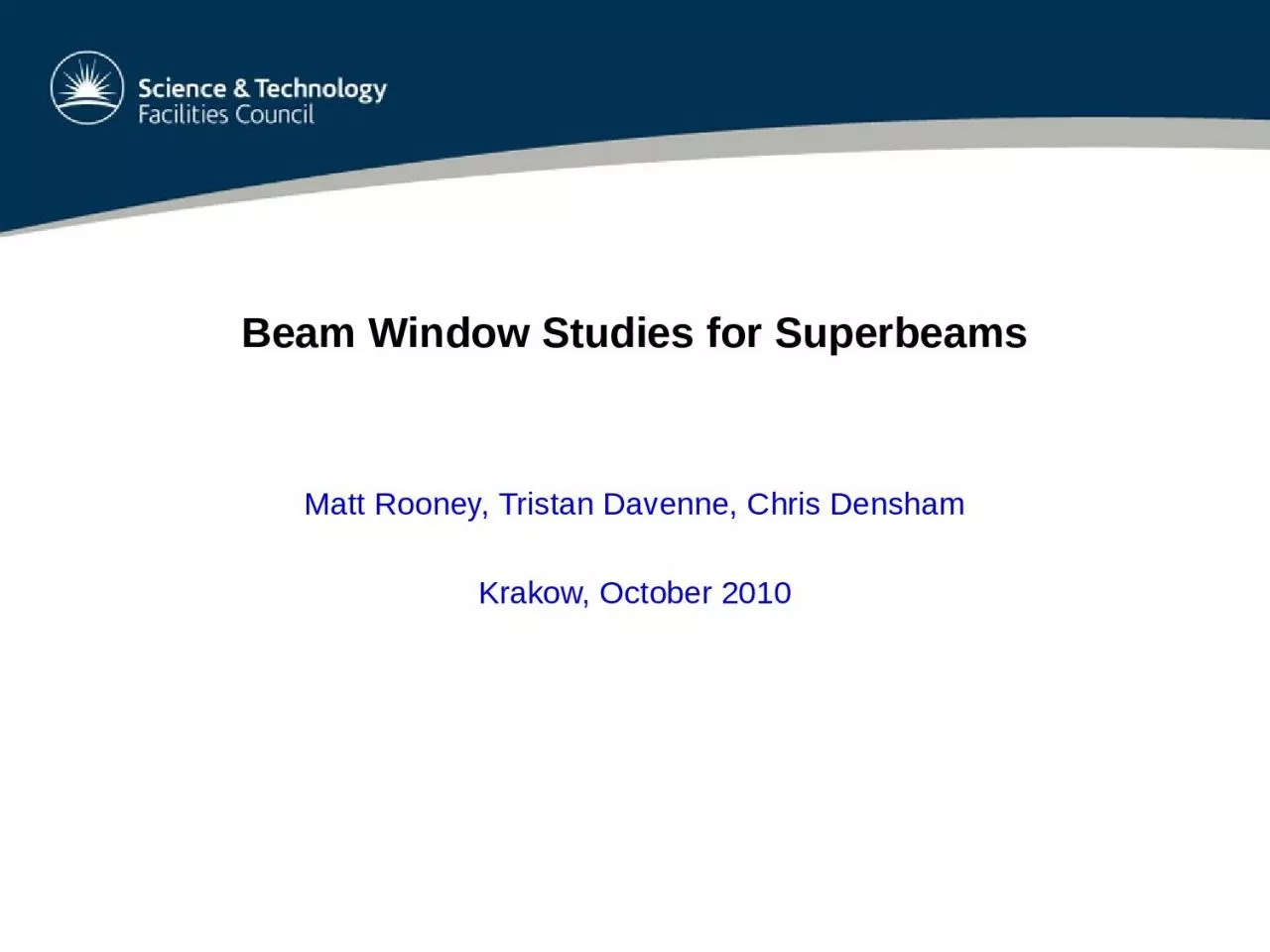

Superbeams Matt Rooney Tristan Davenne Chris Densham Krakow October 2010 Window candidate materials Matt Rooney October 2010 Others candidate AlBeMet Superbeam comparison Matt Rooney October 2010 ID: 1007113
Download Presentation The PPT/PDF document "Beam Window Studies for" is the property of its rightful owner. Permission is granted to download and print the materials on this web site for personal, non-commercial use only, and to display it on your personal computer provided you do not modify the materials and that you retain all copyright notices contained in the materials. By downloading content from our website, you accept the terms of this agreement.
1. Beam Window Studies for SuperbeamsMatt Rooney, Tristan Davenne, Chris DenshamKrakow, October 2010
2. Window candidate materialsMatt Rooney, October 2010Others candidate: AlBeMet
3. Superbeam comparisonMatt Rooney, October 2010EUROnu SPL LBNE (700 kW)LBNE(2 MW)T2KBeam power10.720.75 MWBeam energy5606030 GeVProtons per pulse1.50e145.60e131.6e143.30e14Beam sigma41.53.54.24 mmPeak energy dep.~ 80~ 200~ 128~ 160 J/cc/spillPulse length51055 μsFrequency121.321.320.47 HzNOTE: Energy deposition is for beryllium.
4. Stress analysis – variables studiedBeam parameters:Power: 1 MW (4 MW divided between four targets/windows)Energy: 5 GeV1.5 x 1014 protons per pulseFrequency: 12.5 HzPulse length: 5 microsecondsBeam sigma: 4 mmDesign considerations:Materials: Beryllium (S65C), AlBeMetCooling methods: direct forced convection helium and circumferential waterMatt Rooney, October 2010Beam parameters taken from EUROnu WP2 Note 09-11
5. Energy deposition profileMatt Rooney, October 2010NOTE: Data produced by Tristan Davenne (RAL) using Fluka. A Gaussian approximation of this data has been used in ANSYS for simplicity. Peak is around 80 J/cc/spill for beryllium window A bug was found in FLUKA that means peak may be slightly lower. Needs to be checked.
6. Window energy dep. as a function of beam sigmaMatt Rooney, October 2010LBNE 700 kW (1.5 mm)T2K 700 kW (4.24 mm)EUROnu 1 MW (4 mm)For Gaussian profile beam: (peak energy dep.) x σ2 = constant(assumes constant total heat deposited, confirmed by FLUKA simulations)
7. Typical ANSYS model showing cooling optionsMatt Rooney, October 2010ANSYS Multiphysics v11 used with coupled field elements (axisymmetric model)Window thickness is 0.25 mm.
8. Thermal stress and strainMatt Rooney, October 2010Stress components: Quasi-static thermal stress Stress waves Background stress due to pressure
9. Circumferentially water cooled beryllium windowMatt Rooney, October 20100.25 mm thick beryllium windowCircumferentially water cooled(assumes 2000 W/m2K)Max temp ~ 180 °CMax stress ~ 50 MPa (yield ~ 270 MPa)
10. ‘Shock’ stress due to single pulse in beryllium windowMatt Rooney, October 2010Temp jump of 22°C results in 50 MPa peak stress. When superimposed with other stresses the peak may be around 80 MPa, giving a SF of around 4 on the UTS.
11. Minimum beam size for beryllium windowMatt Rooney, October 2010Design stress is assumed to be half ultimate tensile strength.
12. But UTS falls with temperatureMatt Rooney, October 2010ITER Material Properties Handbook
13. 4 MW windowMatt Rooney, October 2010Yield strength of beryllium @ 260°Cis around 200 MPa. This leaves a safety factor of about 2 for a beryllium neutrino factory window with these beam parameters. 50 pulses (1 second)
14. Empirical heat transfer coefficient of flowing gaseous heliumMatt Rooney, October 20101000 W/m2K would require velocity of around 500 m/s. This is possible but may be very costly.Ref: Y. Yamada. T2K Target Station Interim Design Report. 2005.Dalle Donne formula for turbulent flow: Nu = 0.019r-0.16Re0.8Pr0.5
15. Stress wave interaction at 50 Hz?Matt Rooney, October 2010Stress waves in window dissipate before arrival of next pulse. But this will depend heavily on the geometry. Needs to be studied for target.
16. LBNE Window Studies
17. AlBeMet window as a window materialMatt Rooney, October 2010AlBeMet seems to offer little benefit over beryllium and is relative untested in radiation environment.
18. 3D ANSYS Autodyne simulation of off-centre beamMatt Rooney, October 2010Single pulseon-centre3mm off centre10mm off centre15mm off centreHeat profile imported from FLUKA
19. Off-centre beam resultsMatt Rooney, October 2010Study by Tristan Davenne (RAL) seems to confirm that hemispherical shape is tolerant to off-centre beam pulses. Similar results for multiple pulses, but depends on boundary conditions, i.e. how the window is fixed/welded/joined.
20. Significance of window thicknessMatt Rooney, October 20100.2 mm thick0.1 mm thick0.3 mm thick
21. P-bar Target (FNAL) has a Beryllium cover that regularly sees 1000 J/cc and shows no evidence of damagePossible explanations:1. Small areas of deformation not visibleAnalysis indicates about 0.05 mm of plastic deformation on surface in an outward “bump” with diameter of about 1 mm2. Beam profile is not gaussianAt such small sigma, peak energy deposition would be reduced greatly if profile were flat in center of beam3. Fast energy deposition rate creates high strain ratesYield strength of metals increases for high strain ratesP-bar target at Fermilab (P. Hurh)
22. 120 GeV0.2 mm sigmaElastic/plasticTemp Dependent Mat’l PropertiesPeak Seqv is 300 MPaPeak Temp is ~800 CBe Melting Temp is 1278 CBe UTS at 600 C is ~150 MPaBeryllium P-bar target cover – surviving 1000 J/cc pulses?(results presented by P. Hurh at NBI 2010)
23. Elastic plastic simulation - High intensity beamsMatt Rooney, October 2010ANSYS elastic-plastic simulation using a bi-linear stress strain curve with yield strength 273 Mpa and UTS 453 Mpa (from ITER Material Properties Handbook)
24. Elastic-plastic simulation resultsMatt Rooney, October 2010